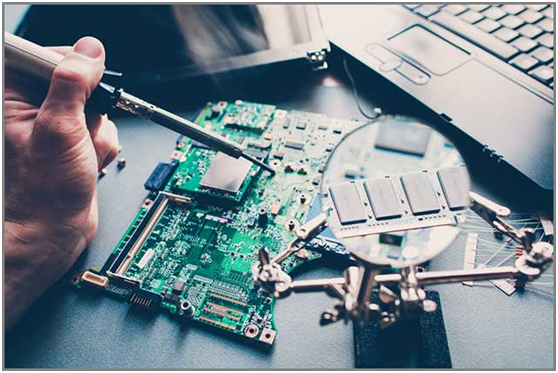Integrated circuits (ICs) and semiconductors are essential elements for powering many modern day digital devices. The global industry that supports the development of these cutting-edge technologies is set to grow into the next decade, largely due to emerging technologies that support autonomous driving, artificial intelligence (AI), 5G, and Internet of things (IoT).
Many of the semiconductor producers are located in East Asia (China, Japan, South Korea and Taiwan). Semiconductor production has been growing steadily due to two major industries: mobile communications and cloud computing. China is the leader in this development while Japan supplies the raw materials for production. South Korea produces memory chips, specifically HBM (high bandwidth memory) and DRAM (dynamic random-access memory). Taiwan is a world-leading foundry for semiconductors.
Unfortunately, supply chain issues over the past few years created chip shortages that stalled electronics production. The primary issue had been a lack of fabrication capacity. Production has been steadily increasing again and the industry is slowly recovering, but the question still remains: will production meet the demands of industrial growth?
No matter the current state of availability for ICs and semiconductors, electronics enthusiasts continue to build and develop fun and exciting projects. Arduino is a perfect example. Arduino is an easy-to-use hardware and software platform used for building electronic projects. Many semiconductor suppliers can be found online, ensuring there are still plenty of components available for projects.
A platform such as Arduino is a great way to learn andunderstand more about electronics. But don’t let simplicity fool you. There are thousands of additional components available that allow you to build and program just about anything you can imagine. Hobbyist students andresearchers will often use Arduino forprototyping applications before scaling up.
Getting ahead with electronics starts with learning. There are lots of resources available, but it’s important to stay focused and start with the basics. Thankfully, hobbyists love teaching other hobbyists, so you can easily find a plethora of videos online that introduce you to the projects you plan to work on. Be sure to take notes and follow up on anything that seems confusing or difficult. You can enhance your note-taking abilities by dedicating a notebook for each area you are trying to learn about. Sort each notebook by topic so it’s easy to find what you’re looking for. Electronics is a vast area of study and will require some time and patience to master.
It’s a good idea to start with the fundamentals of electronics, starting with circuits, voltage, current, resistance, and how these things go together. Once you understand the basics, you can start building circuits. By building a circuit and adding components you will have a better understanding of electronics and the way things work together.
Some of us learn better by reading, but some of us learn better by doing. Take the time to read about the things that interest you, but don’t be afraid to take on a simple project for practical, hands-on experience. Being able to see things visually often helps with understanding how things work, which in turn makes it easier to expand your knowledge.
Integrated circuits
A lot of first projects will be simple and only use basic parts. But as you learn more, you can add components that will expand the functionality of your project. ICs, for example, can add sound, memory, AI (artificial intelligence) and more. It might sound strange, but an integrated circuit is simply a circuit mounted on a microchip. An IC can be anything from an amplifier, a transmitter, or a microcontroller. Since these circuits are small, they can be used in thousands of applications without being concerned about space requirements. For example, a GPS (global positioning system) chip easily fits into your cell phone.
Semiconductors
Asemiconductor is a substance with resistance between a conductor and an insulator. Don’t let the definition confuse you. The important thing to know is how semiconductors are used. Semiconductors are used in electronic devices which are compact, reliable, power efficient and are inexpensive to produce. Semiconductors are used in everything from smartphones to spacecraft.
The biggest advantage of semiconductors is their size and low power consumption. They are durable and efficient. One common use for semiconductors is in computing. They facilitate the use of binary code so computers can perform the commands programmed into them. Basically, semiconductors are what allow you to program your applications and perform tasks when building an Arduino project.
Microcontrollers
A microcontroller is basically a small computer on a semiconductor chip. A microcontroller contains a CPU (central processing unit), memory, and a means for input and output. The difference between a computer and a microcontroller is how it’s used. Microcontrollers are used in embedded applications and for portable devices, industrial automation, home appliances, medical devices, robotics, aircraft, spacecraft, and more.
A microcontroller, along with ICs and semiconductors, are what allows you to build things and get ahead in electronics. By adding additional components, there are few limits to what you can make.
Conclusion
We looked at where ICs and semiconductors are being produced and noted that supply chain issues are causing shortages. It’s clear demand for these products will continue to grow as emerging technologies and innovation drive their needs.
Electronics enthusiasts continue to design, build and prototype projects using tools like Arduino. Although there’s a shortage for some parts, many components are still available online.
Getting ahead in electronics starts with learning. Finding the right books, videos, and tutorials can get you started and help you understand more about electronics. Taking notes and creating notebooks to track and document the topics that interest you will make it easier to find what you need as you build a project. It always helps to stay organized.
Integrated circuits can add functionality like sound and AI to your project. These circuits are small which allows them to be used in small and portable devices easily. Semiconductors allow you to program applications and perform the tasks for your project. Microcontrollers are the brains of a project complete with a CPU, memory and connections for inputs and outputs. No matter your interest and as long as you start learning and trying hands-on projects, you will get ahead in electronics. As you start adding components to projects like ICs and semiconductors, you will be able to build just about anything you can imagine.








